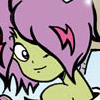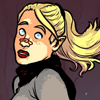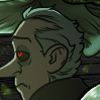Know Thy History: Li’l Abner

It’s always rather inspiring to read about people overcoming physical disabilities to make a name for themselves. As Fox Mulder once said, “I’ve always wanted a peg leg. It’s a boyhood thing I never grew out of. I’m not being flippant; I’ve given this a lot of thought. I mean, if you have a peg leg or hooks for hands then maybe it’s enough to simply keep on living. You know, bravely facing life with your disability. But without these things you’re actually meant to make something of your life, achieve something earn a raise, wear a necktie.”

Alfred Caplin faced such a set-back. He was born in New Haven, Connecticut, and he came from a very poor family. How poor? He once related a story about how his mom had to sift through ash barrels just so the family could have enough heat. At age 9, Caplin faced another setback: he lost his leg due to a trolley accident.
It’s a tragedy to lose a leg at so young an age. It’s enough to crush the spirits of most people. But Alfred Caplin still possessed a hand to draw with and a quick-witted mind. He grew up to be Al Capp… no, not that drunk British cartoon character, but one of the most influential cartoonists in America thanks to his quintessential comic, Li’l Abner, which ran in papers from 1934 to 1977.

How influential was Li’l Abner? Let’s see:
- Li’l Abner inspired the creation of both a movie and a Broadway musical. A movie, by the way, that starred future Catwoman Julie Newmar in the role of Stupefyin’ Jones.
- The comic led to the observance Sadie Hawkins Day, when high-school and college-aged girls could actually ask out guys to the school dance.
- Li’l Abner also created the fantastical creature known as a Shmoo, which has become an actual term in socioeconomics, microbiology, particle physics, and electrical engineering.
- Fearless Fosdick, the comic within the comic, is credited as being one of the primary inspirations behind MAD Magazine.
- Was the inspiration behind the name of Lockheed’s special aircraft division, Skunk Works, which was responsible for the creation, among many things, of the iconic SR-71 Blackbird.
- Launched the careers of Mell Lazarus (Miss Peach and Momma) and FRANK. FRIGGIN’. FRAZETTA.
I know I’m leaving out a lot, like how Li’l Abner characters tended to show up on the names and nose art for WWII airplanes thanks to a healthy fanbase of young American soldiers. Or how Al Capp inspired the likes of Frank Cho. Or how Li’l Abner is likely the inspiration behind The Beverly Hillbillies (the Clampett clan lines up incredibly well with Li’l Abner‘s main characters). Or how Al Capp, thanks to the high hems of his female characters, claims to have invented the miniskirt. It’s enough to say that Li’l Abner was a pop culture powerhouse of epic proportions.

Some commentators on Al Capp’s life point out that his paraplegic state drove some cynicism that can be found in the Li’l Abner strips. It’s true that Li’l Abner does have an edge to them. However, it’s only there if you look for it. Most of the time, it’s all goofy silliness, running gags, and surreal flights of fancy. I mean, geez, are we going to attribute Capp’s love of luscious lady legs to the fact that he was lacking a leg of his own? (Hmmmm…. HMMMMMM….)
Li’l Abner lives in Dogpatch, a hillbilly paradise. It was originally located in Kentucky* (STILL America’s designated backwater, if FX’s Justified is to be believed), but Capp eventually dropped any specific location out of concern over alienating his readers. Everybody in Dogpatch and vicinity is dumber than a bag of hammers. Only two people can actually read. They don’t like filling out their 1040-EZ’s, either; there’s a story where a B-29 drops the latest nuclear weapon on Dogpatch; the government assumes the area is uninhabited because they never had any record of anyone there paying taxes. And yet, whenever city-folk ever came to Dogpatch, the locals would, most of the time, prove to be far more clever than the rubes that lived in the city.
Heck, the world of Li’l Abner was surprisingly subversive. It was a world full of gender role reversals, considering that this was printed back in the 1930’s. The strongest person around is Li’l Abner’s tough old mom (who was, reportedly, Al Capp’s favorite character). She was smashing her fists in young men’s faces long before Rosy the Riveter became a national icon. Plus there’s that whole Sadie Hawkins thing, which was fun for the college kids but also probably kinda scandalous to the gray-hairs of the day.

That’s not to say that Al Capp didn’t appreciate the pleasant aesthetic qualities of the female form. You can tell with Capp’s lovingly drawn illustrations of long-suffering sweetheart Daisy Mae, who probably was way too passive for her own good. There was also sexy pig farmer Moonbeam McSwine, the Stupefyin’ Jones (so named because she’s stupefyingly hot), and the (probably) cannibalistic Wolf Gal. All drawn smokin’ hot.
Well, all except the ugly ones. Most notably, Lena the Hyena, the ugliest woman on Earth. Most of you will remember her for her memorable appearance in Who Framed Roger Rabbit?… probably the only representative of the print world to make an appearance in that joined animated universe. Interestingly, animated Lena was actually more attractive than her comic design, which was created by MAD Magazine legend Basil Wolverton as the winning entry in the “Draw Lena The Hyena” contest.
Anyway, most all of them would be throwing themselves at the hunky Li’l Abner sooner or later.

The men, on the other hand, were generally useless. Oh, yeah, L’il Abner was definitely the Alpha Male, but he was a manchild before that term was even invented. He sneaks of off to either fish, box, or bury his head in his comic books. If he were around today, he’d probably be eating Doritos and playing Xbox.
While his love for Daisy Mae is never in question, he tends to shun her repeatedly… mainly because showing any affection would lead to marriage, and that means that the fun times are over. So always he’d leave her hanging … though not forever. Li’l Abner and Daisy Mae were eventually got married in 1952 (while still in his knickers) after the readers put the pressure on Al Capp. The event was so momentous, it made the cover of Life magazine. (All the more impressive when you consider every other cover featured a classy black-and-white photo of the celebrities of the time.)
This didn’t stop Li’l Abner from being a total jackwad, by the way. On the way to the honeymoon, he had Daisy Mae carry the giant ham. Stay classy, bro. Anyway, to preserve the “will-they-won’t-they” chemistry that had sustained Li’l Abner for so long, romantic subplots would eventually shift to Abner’s equally dimwitted yet beefier kid brother, Tiny Yokum.
The other men were not portrayed any better. They’re generally filthy, stupid, and ugly. (Except the city men, who are just milksops.) Abner’s pa, or example, was about the most useless character in the comic … and probably ended up being a damsel in distress more than any of the womenfolk.

Li’l Abner was aimed for adults rather than kids, pretty much The Simpsons of its day. And, like our current crop of for-adults cartoons, it was full of some snide political commentary. For example, the infamous Shmoos. Li’l Abner discovers them one day, and finds out that they’re absolutely all-purpose. They are both absolutely delicious (they happily jump into frying pans and pots and take on different flavor properties depending on how you cook ’em) and endlessly entertaining (their dancing makes no one want to listen to the radio or watch TV). But soon they’re hunted down by “Shmooicide Squads” for being a danger to capitalism. In later stories, the Schmoos would be targeted by the government as threats to national security. Greed is always their undoing. The problem with Shmoos is summed up by the always wise Moonbeam McSwine: “Ah wonders ef hoomanity will ever be good enuff fo’ the Shmoos!”
From time to time, Capp would stray from the adventures in Dogpatch and try to expand in new directions. His most notable deviation from the Li’l Abner formula was Fearless Fosdick. Fosdick, a parody of Dick Tracy, was Abner’s “ideel” (which, incidentally, drove Daisy Mae crazy) and was created by an insane cartoonist Lester Gooch. He was grim, determined, and faced villains with the world’s dumbest gimmicks. Yes, even dumber gimmicks than the ones on The Cape! One minute, he’s facing Bomb-Face, a guy with a bomb for a face. The next, he’s facing down a villain who is a Chippendale chair. Somewhere, The Tick creator Ben Edlund was paying attention.
Li’l Abner eventually came to an end in 1977, only a couple of years before Capp’s death in 1979. Despite being set in a bumpkin backwater, its 43 year run chronicled the heyday of American culture … from the Depression-era poverty of the 1930’s and the zoot suit era of the 1940’s to the filthy hippies of 1970’s. Capp left a heck of a legacy, as well as these immortal words to live by, as spoken by Mammy Yokum:
“Good is better than evil, because it’s nicer.”
* – An earlier version of this said that Dogpatch was in “West Virginia,” not “Kentucky.” Fortunately, it turns out my reference to Justified was OK; that show is actually set in Kentucky, too. (I had to eliminate the BIlly Ray Cyrus reference, though, since he’s West Virginian, just like Brad Paisley.) Apologies to West Virginians, but, shucks… you’re ALL America’s Backwater to me! (And if it makes y’all feel any better, Dogpatch was actually based on the more classy-sounding Seabrook, New Hampshire. Which is to say, America’s Backwater is everywhere.)
Posted on March 3, 2011, in comics, Know Thy History, The Webcomic Overlook and tagged li'l abner. Bookmark the permalink. 13 Comments.












































































































I love that you do these Know Thy History things. Please keep doing them! They’re fabulous to read and learn about!
Thanks! Its fun for me to look for them, too. Pretty much all of these comics I’m digging up are the first time I’m seeing them as well, and sometimes directions take me in strange places. For example, I was thinking of doing a profile of Fritzi Ritz for my next entry, as Ernie Bushmiller one of the later era artists, is going to be honored at the Eisners this year. But then I found out that Fritzi was inspired by an even earlier comic, Polly & Her Pals, and I thought, “Huh! Maybe the original flapper comic would be an interesting subject to cover!” I have no idea what I’ll blog about, ultimately, but the journey itself has been very interesting and highly educational.
Do you know of a good place to read this comic online? It sounds very interesting.
Well, the “I Love Comics Archive,” which I link to several times in this review, is probably the best site for Li’l Abner archives.
http://www.ilovecomixarchive.com/L/Lil-Abner
I think it may actually be the deepest archive on the site, since there’s a pretty adamant Li’l Abner collector’s club out there. My personal recommendation as a starting point, by the way, would be the “Shmoo” saga of 1948. Capp was at the height of his satirical game, and it’s pretty much the point Li’l Abner really took off with the public. (Like, really took off with the public. There was Shmoo merchandise everywhere, and when a pallet of it was dropped into Berlin as part of the Berlin Airlift, it caused a near riot.)
You can check it out here:
http://www.ilovecomixarchive.com/L/Lil-Abner/Lil-Abner-1948/11492010_UsP38#808951416_dtf2s
There’s also several reprints available — IDW just started printing the complete archives, and are up to Vol. 2 (1938) thus far — but that can get pretty pricey. Plus the early years? Not as good as the stuff in the late 40’s. (I’m personally saving up my money for that collection.)
Thanks El Santo. By the way, where do I recommend comics for review?
You can e-mail them to me. I can’t guarantee that I will ever get to them (I sort of follow my own path over which webcomics to review these days), but it won’t hurt.
I grew up with LI’L ABNER, during what was the Golden Age of newspaper comics (although we didn’t know that at the time), so the strip and its vivid characters are indelible to me. I can’t remember a time when I didn’t follow ABNER. It seems I’ve loved it all my life, and thanks to modern reprints, I’m happy to report that it’s STILL hilarious. Al Capp ranks up there with the greatest literary satirists who ever lived. His best work holds up like damn few relics of one’s childhood ever do. LI’L ABNER remains – by far – my favorite comic of all time.
It’s certainly refreshing to read a young person’s perspective on this undisputed, 100% bona-fide American classic. Thanks for sharing.
Thanks! I’m glad you enjoyed it.
Hello. I just want to say thank you for doing this. and actually I was wondering if you could help me out. I am a senior in highschool, and to graduate I have to write a 6-8 page research paper and create a presentation based on, my thesis, which is how older cartoons and animation have influenced culture and history then and now. If you can help me with my research that would be great. Because in all honesty I really don’t know where to start.
Well, I think a browse through most of my “Know Thy History” pieces is a good starter. I try to weave in how comics have, in fact, been weaved into culture beyond just the comic culture. The trivia on Alley Sloper, The Yellow Kid, The Dragon Lady, Sheena, and Rube Goldberg may especially be eye opening.
Pop says LIT’L ABNER was his all-
time favorite. (It also probably inspired the DUKES of HAZZARD)
. p.s. LIt’l Abner didn’t just “fish, box, and read comicbooks.” He worked…..as a mattress tester in the nearby mattress factory!
Hi there,
We’re writing a piece here at The Daily Meal about Sadie Hawkins’ Day and how it was celebrated in the Li’l Abner comic strip. I was wondering if we could use one of the strips you have posted here. We’ll absolutely give credit, and we’d be happy to link back to your site if you wish. Please email me at jbruce@thedailymeal.com. Thanks so much!
Best,
Jane Bruce
Photo Editor
The Daily Meal
Pingback: The Webcomic Overlook #231: MS Paint Adventures: Homestuck (Acts 1-4) | The Webcomic Overlook